Q: Is all this talk about strengths actually found in the scriptures?
A. Yes.
Ministry Insights was founded on the biblical principle of uniqueness: God created you and each person around you with unique strengths. He has placed you together to build His Kingdom.
 This principle from God’s Word establishes a foundation for understanding ourselves and our relationships. It allows us to see that our differences are strengths when allowed to function as God designed. God’s desire in our relationships is for our differences to unite us, not divide us.
This principle from God’s Word establishes a foundation for understanding ourselves and our relationships. It allows us to see that our differences are strengths when allowed to function as God designed. God’s desire in our relationships is for our differences to unite us, not divide us.
But don’t take our word for it. Go to the Word instead. Study the biblical basis for strengths for yourself.
The key scriptures below explain God’s plan for our uniqueness. We hope you can read them, study them, and discover for yourself God’s design for differences.
You can read and study these passages any way you like. Here are a few suggestions:
- Click on the links to read and study these passages on Bible Gateway in your browser.
- Look up the passages in your own Bible or app to read and study them.
- Download our free guide, Key Scriptures to Help You Lead from Your Strengths, which has each of these passages printed out with room for you to take notes as you study.
As you find additional verses that speak to strengths and differences, please share them with us in the comments below, on social media, and by email so that many more Christ-followers can grow, too.
More Tools for Studying the Bibilcal Principle of Strengths
How to Study Scriptures about Strengths, Part 1: Read Different Bible Versions
How to Study Scriptures about Strengths, Part 2: Do a Keyword Search
How to Study Scriptures about Strengths, Part 3: Check Bible Dictionaries
How to Study Scriptures about Strengths, Part 4: Compare Bible Commentaries
Each of us is wired differently to give and receive information in various ways. These differences in communicating are part of what makes each of us unique.
What would happen if you could customize the way you go about communicating with others, personalizing it in the way they can best receive it?
That’s one important benefit of the Leading From Your Strengths profile and Marriage Insights profile. These detailed 20-page reports accurately describe the user’s habitual patterns of behavior, thought, emotion, and communication. The reports are especially helpful when it comes to communicating with other people – particularly those who communicate differently than you.
Uniqueness in each of us makes it easier to hear information when it is presented in certain ways … and more difficult to hear when presented in others. The report shows you what keys to look for in order to customize your communication with others in ways they can hear it.
Two Keys to Customizing Your Communication
You need just two pieces of information in order to customize your communication with another person.
1. You need to know the person’s most well-defined natural strength.
By identifying the other person’s most well-defined natural strength, you will understand how he is wired to receive information. Ask to see his profile report. In which of the four areas (problem solving, processing information, managing change, and facing risk) does he have a clear dominant score? Take note of it
2. You need to know tips for communicating best with a person who demonstrates that strength.
We all have “gifts that differ according to the grace given to us” (Romans 12:6). Once you are aware of the other person’s most clearly-defined area of strength (problem solving, processing information, managing change, or facing risk), you can customize your communication to fit that bent.
Use these frequently asked questions to help you learn how to communicate best with people who exhibit strengths that are different than yours.
FAQ #1: When it comes to problem solving, what are the best ways to communicate with a person who demonstrates Aggressive traits?
This person can be ambitious, forceful, decisive, strong-willed, independent and goal-oriented. When communicating with him, be clear, specific, brief and to the point. Stick to business. Be prepared with support material in a well-organized “package.”
Note that you’ll create tension or dissatisfaction with this person if you talk about things that are not relevant to the issue. Don’t leave loopholes or cloudy issues. Avoid appearing disorganized.
FAQ #2: When it comes to processing information, what are the best ways to communicate with a person who demonstrates Optimistic strengths?
This person can be magnetic, enthusiastic, friendly, demonstrative, and political. When communicating with him, provide a warm and friendly environment. Don’t deal with a lot of details – put them in writing instead. Ask “feeling” questions to draw out this person’s opinions or comments.
Note that you’ll create tension or dissatisfaction with this person by being curt, cold or tight-lipped or by attempting to control the conversation. Try to avoid a focus on facts and figures, alternatives, or abstractions.
FAQ #3: When it comes to managing change, what are the best ways to communicate with a person who demonstrates Predictable traits?
This person can be patient, predictable, reliable, steady, relaxed and modest. When communicating with him, begin with a personal comment to break the ice. Present your case softly and nonthreateningly. Ask “how?” questions to draw out his opinions.
Note that you’ll create tension or dissatisfaction with this person by rushing headlong into business. He doesn’t respond well to domineering or demanding interchanges. Avoid forcing him to respond quickly to your objectives.
FAQ #4: When it comes to facing risk, what are the best ways to communicate with a person who demonstrates Structured traits?
This person can be dependent, neat, conservative, perfectionistic, careful and compliant. When communicating with him, prepare your case in advance. Stick to business. Be accurate and realistic.
Note that you’ll create tension or dissatisfaction with this person by being giddy, casual, informal, or loud. He won’t respond well if you push too hard or are unrealistic with deadlines. This person doesn’t respond when conversations are disorganized or messy.
Customized Communication: Is It a Crutch?
What would you say to the argument that knowing a person’s strengths in order to communicate with him is at best a crutch — and at worst manipulative?
Naturally, check your motives to be sure your intent is for understanding.
Beyond that, know that forming your thoughts into words that another person can hear takes care, purposefulness, and wisdom – qualities that God desires. Rather than a crutch, information about how another person communicates is a tool that helps you build bridges.
Solomon put it well: “The heart of the wise makes his speech judicious and adds persuasiveness to his lips” (Proverbs 16:23, ESV).
Communications Tips (in chart form)
More FAQs: Frequently Asked Questions
FAQs: Report Consolidation Template – Your Profile on One Page
FAQs: Tight Patterns and Neutral Graphs
FAQs: The Energy Line on the Strengths Charts
Merge Profile Highlights with a Few Clicks
Your Leading From Your Strengths profile report (or your Marriage Insights profile report) are personalized, detailed 20-page reports which accurately describe your individual habitual patterns of behavior, thought, emotion, and communication. They provide a considerable amount of data about your unique strengths that you can use at your job, at home, and in ministry in order to work with others more effectively.
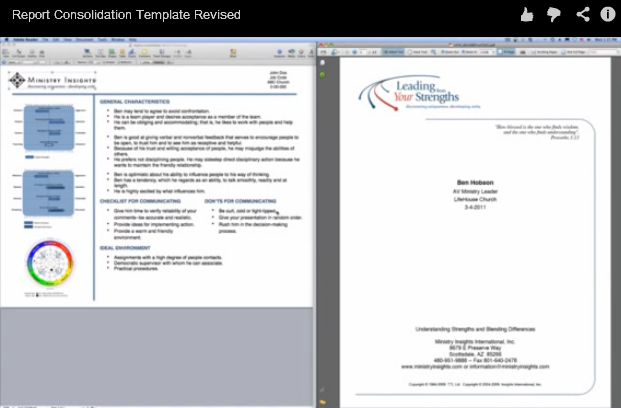 One challenge to the report – a good one – is that it offers a large amount of information. Wouldn’t it be handy to be able to see the highlights of the report in one quick glance?
One challenge to the report – a good one – is that it offers a large amount of information. Wouldn’t it be handy to be able to see the highlights of the report in one quick glance?
The Report Consolidation Template allows you to do that. As you work with the template and your profile report together, you select statements and visuals out of your profile and combine them onto a one-page, overview document in the template.
These are the most frequently asked questions about the Report Consolidation Template and how to use it.
FAQ #1: What steps do I need to take before I begin to consolidate my profile report?
- Review your profile report and highlight statements from General Characteristics, Do’s and Don’ts in Communication, and Ideal Environment that summarize you best. Choose 5-10 statements from General Characteristics and 3-5 statements each from the other sections.
- Download a copy of the Report Consolidation Template from the Ministry Insights website and then save it. The template is available as a Word document (PC users) and a Pages document (Mac users).
FAQ#2: Do I need special software to use the template?
Use typical software for editing functions: Pages for Mac users and Microsoft Word for PC users. You also need to make sure you have an updated version of Adobe Acrobat Reader, available as a free download, installed on your computer in order to read the profile as delivered in an Adobe PDF (portable document file).
FAQ #3: What steps do I need to take to consolidate my report?
- Make a copy of the downloaded Report Consolidation Template and save it with the profile name.
- Set up your computer screen so you can view the saved template and the profile report side by side.
- Make sure you’re familiar with basic text editing functions needed to copy and paste visuals and statements from an Adobe PDF file (your profile report) onto a Word or Pages document (the saved template.) To copy and paste visuals, use Adobe’s Snapshot tool. To copy and paste statements, use Adobe’s Select Text tool.
FAQ #4: What content should I transfer from the profile report to the template?
The template is set up so that you can insert images onto the left column (Natural Strengths Chart, Strengths Movement Chart, and Strengths Wheel) and statement in the right column (General Characteristics, Do’s and Don’ts in Communication, and Ideal Environment.) However, you can paste any data from your profile report that you choose.
FAQ #5: What steps do I need to take to transfer data from my profile onto the template?
- Use the Select Text tool to copy and paste your name and identifying information from the profile PDF title page onto the upper right corner of the template.
- Use the Snapshot tool to copy and paste the Strengths Chart, Strengths Movement Chart, and Strengths Wheel from the profile PDF onto the template.
- Use the Select Text tool to copy and paste statements from General Characteristics, Do’s and Don’ts in Communication, and Ideal Environment (or other sections and statements) from the profile PDF onto the template.
FAQ #6: What makes the Report Consolidation Template so useful?
It’s useful in the workplace. Leaders ask staff members to complete the profile but then are faced with the monumental task of reviewing multiple 20-page reports. As you undergo the profile process with your staff, ask each one to complete the Report Consolidation Template, too. This way you can see each staff member’s profile at a quick glance.
It’s useful in your marriage. When both you and your spouse complete a report consolidation, you can view the two copies side-by-side together and individually.
It’s useful in your family. When each member can see the other’s report in one quick glance, you can see each other’s strengths. Overview documents used together can help you and your family put together an action plan to build stronger communication.
It’s useful for yourself. Your personal report consolidation can be a simple tool to use to refer to as you work short- and long-term to learn to lead from your strengths.
Help Video
Help Video: How to Use the Report Consolidation Template
More FAQs: Frequently Asked Questions
FAQs: How to Customize Your Communication with Other Strengths
FAQs: Tight Patterns and Neutral Graphs
FAQs: The Energy Line on the Strengths Charts
What Do They Mean?
Your Leading From Your Strengths profile report (or your Marriage Insights profile report) includes two personalized charts: your Natural Strengths Chart and your Strengths Movement Chart. These charts are a visual representation of the data compiled from your questionnaire. The charts reveal your strengths in four areas: problem solving, processing information, managing change, facing risk.
Your plotted scores create a visual pattern in a graph. Each person’s graph is different because each person’s strengths are different.
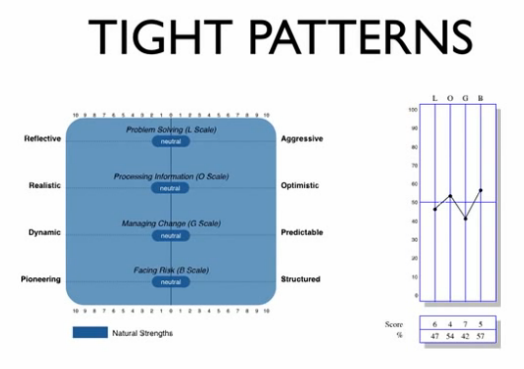 However, one type of graphed result is somewhat unusual and needs special consideration: a graph with a tight pattern or a neutral pattern. What do those kinds of profile results mean and how should you proceed if yours is like that?
However, one type of graphed result is somewhat unusual and needs special consideration: a graph with a tight pattern or a neutral pattern. What do those kinds of profile results mean and how should you proceed if yours is like that?
The following questions are asked most often about tight patterns and neutral graphs.
FAQ #1: What is a tight pattern on the profile graphs?
A tight pattern on the profile graph is one in which all scores in the four areas of differences are either neutral (0) or within one or two points on either side of the Energy Line (1 or 2). A tight pattern can occur on either the Natural Strengths Chart or the Strengths Movement Chart.
FAQ #2: What is a neutral graph?
In the strictest sense, a neutral graph is one in which the scores in each of the four areas are labeled “neutral.” However, for general purposes the term “neutral graph” is considered to be nearly synonymous with “tight pattern.”
FAQ #3: What does a tight pattern or a neutral graph indicate?
These two unusual patterns indicate stress or discomfort.
If the pattern occurs on the Natural Strengths Chart, then the stress or discomfort is internally-driven, meaning the user is struggling with an identity issue or personal conflict. The tight or neutral scores reveal that the user may have attempted to outsmart the questionnaire, over-analyzed the questions, is experiencing a significant emotional event or personal trauma, or is under pressure to be someone he is not.
If the pattern occurs on the Strengths Movement Chart, then the stress or discomfort is environmentally-driven. The user’s current environment or expectations within that situation are creating conflict. Like the individual with tight graph responses in a Natural Strengths Chart, this person may have attempted to outsmart the questionnaire or over-analyzed the questions. But this person may face two other challenges. He may be trying to be an overachiever. Or he may be new to his job or environment and may not yet understand the behavior that is required in order for him to be successful.
FAQ #4: What steps should I take if the Natural Strengths Chart reveals a tight pattern or neutral graph?
By processing the information on the graphs, the user can discover the factors that are influencing the tight pattern or neutral graph . Look for the factors by asking these questions:
1. Are you experiencing a significant emotional event or a personal trauma? Most tight patterns are driven by upheaval in some form.
2. Do you feel you were over-analyzing the questions in the profile assessment by taking too long to respond?
3. Do you feel under pressure to “be all things to all people”?
While these three factors are the most predominant causes for tight patterns and neutral graphs, in a few cases you may not get anywhere. If so, then ask this additional question: Were you trying to outsmart the questionnaire?
If the individual answers yes to any of these four questions, move on to Exercise 1 to help them uncover truths about his or her strengths. If the individual answers no to all of the questions, then move directly to Exercise 2.
FAQ #5: Describe Exercise 1.
Go to the General Characteristics section of the profile. Have the individual read the first statement and indicate if it is true. The individual will have one of four responses.
- “Yes, it is true.” If the individual says it is true, have them expound on it.
- “No, it is not true.” If the individual says it is false, have them explain why. Determine if the statement should be blotted out or if the person might have a blind spot.
- “Yes, but it needs to be edited.” If the individual says the statement needs to be edited, ask them to do so. Encourage them to share further what part of the statement is true and what about it needs to be changed.
- “It is questionable” or “I’m not sure.” In this instance, the individual is not certain whether or not the statement is true. Probe more deeply. Invite someone else into the discussion to help clarify the truth of the statement – perhaps a professional or someone that knows the individual well.
Use this process with the first 17 pages of profile – each statement in the General Characteristics section, along with statements in the Do’s and Don’ts for Communicating and other sections.
After completing the process, have the person retake the questionnaire, using guidelines for Exercise 2.
FAQ #6: Describe Exercise 2.
Exercise 2 allows the person to re-take the profile, but with the encouragement to keep the following in mind:
- Remember that there is no pass or fail.
- Know that there are no right or wrong answers.
- Do not try to give answers that seem favorable or politically correct, but rather answer as honestly as possible. The assessment looks only at strengths.
- Push through the questionnaire to do your best to complete it in 10 minutes or less.
Self-Discovery Is Powerful
The goal is to help the individual to discover more information about his or her strengths. The act of discovery is powerful. Take your time as you work through the process with your profile or as you serve another as a certified practitioner. A tight pattern or neutral graph offers the user the opportunity to dig deeper and discover more about his strengths.
While tight patterns or neutral graphs may require more effort to decipher than other results, the outcome can be exciting and life-changing. By undergoing this process, you are helping put off those concepts that may be confusing or creating struggle as you “Test all things (and) hold fast to what is good” (1 Thessalonians 5:21, NKJV).
Help Video
Help Video: How to Read Tight Patterns and Neutral Graphs
More FAQs: Frequently Asked Questions
FAQs: How to Customize Your Communication with People Who Have Other Strengths
FAQs: Report Consolidation Template – Your Profile on One Page
FAQs: The Energy Line on the Strengths Charts
How It Works and What It Shows
Your Leading From Your Strengths profile report (or your Marriage Insights profile report) includes two personalized charts: your Natural Strengths Chart and your Strengths Movement Chart. These charts are a visual representation of the data compiled from your questionnaire, arranged horizontally.
They reveal your strengths in four areas: problem solving, processing information, managing change, facing risk. The charts read like a continuum, with a line down the middle dividing the four areas. That line is called the Energy Line.
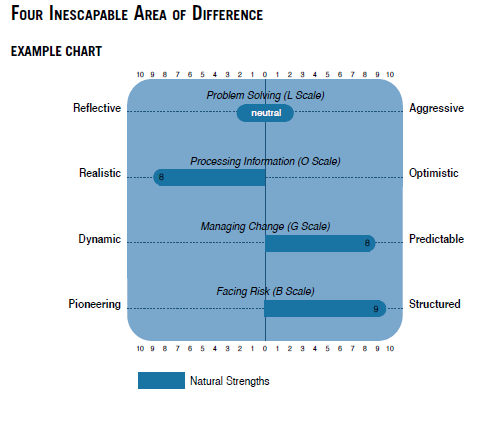 These are questions users ask most often about the Energy Line on your Natural Strengths Chart and your Strengths Movement Chart.
These are questions users ask most often about the Energy Line on your Natural Strengths Chart and your Strengths Movement Chart.
FAQ #1: Why Are Four Areas Measured on the Charts?
The four areas represent four processes that comprise your daily life. Think about it: every action you take falls into one or more four categories: you solve problems, process information, manage change, and face risk.
Why measure these processes? Each of us is uniquely wired by God to handle these actions differently. “There are different kinds of gifts, but the same Spirit distributes them” (1 Corinthians 12:4, NIV).
Those contrasts can be quite intense. For instance, when it comes to solving problems, you may be bold and decisive. Your work colleague, on the other hand, might be more cautious.
Neither is a “right” approach nor “wrong” approach. They are simply different – and both are useful. Our differences are not based on a sliding scale of value. In fact, the different ways we handle our actions in the four areas are actually strengths. Paul says, “Now to each one the manifestation of the Spirit is given for the common good” (1 Corinthians 12:7, NIV).
The visual representation, on a chart, measures these four areas and allows you to understand those differences better.
FAQ #2: What Does the Energy Line Indicate?
The Energy Line in the center of the chart marks a baseline. You can see how the line passes through each of the four areas. Of the four, each has two dominant strengths, totaling eight potential strengths.
The Energy Line is a point of distinction, at which your behavior trends towards one strength or another in one of those areas. The line is a means of showing contrast. For instance, when you receive new information are you easily persuaded to believe it – or are you naturally skeptical? Your natural bent, plotted on the Processing Information continuum, shows which inclination is most natural to you. Scores on either side of the Energy Line reveals a strength, but those two strengths very different from each other.
FAQ #3: Why is Each Area Measured with a Number?
The Energy Line is the center of a continuum and marks intensity. It marks the scale on which how different people handle the four areas differently
Intensity levels are measured in the four areas on a scale of one to ten. Higher scores (those furthest from the Energy Line) indicate a more intense strength in that area. . On the continuum, adjacent scores may not appear to be perceptibly different form each other. However, the extremes on either end are quite distinct.
FAQ #4: What do scores at or near the Energy Line indicate?
Scores near the line reveal the individual’s ability to trend either way in that area, depending on circumstances. For instance, a score at or near 0 in facing risk indicates you can be precise and orderly when the situation warrants that behavior, but also fearless and unconventional when needed. Your strength can be termed as situational.
FAQ #5: How can I use this information?
As you study your scores in relation to the Energy Line, ask yourself these three questions:
- Where are my scores in the four predictable areas?
Note where your scores plot in the four areas. Then study their intensity, specifically looking at your highest two or three scores, no matter which direction they are placed related to the Energy Line (as in the Structured Predictable Realistic in the chart above.) These indicate your overall behavioral bent. - On my Strengths Movement Chart, do any of my scores cross the line?
Note any areas in which your adapted strengths scores cross the energy line into the opposite strength. This shows areas in which you may expend considerable energy to adapt, which may be reasons for feelings of frustration and stress. - Should I take any action based on what I learned?
How can you maximize your natural strengths in your work, marriage, family, and ministry? Take note of how your strengths complement those in your family and on your team. Share your conclusions with your spouse, a trusted friend, or a certified practitioner to make an action plan.
More FAQs: Frequently Asked Questions
FAQs: How to Customize Your Communication with People Who Have Other Strengths
FAQs: Report Consolidation Template – Your Profile on One Page
FAQs: Tight Patterns and Neutral Graphs
Where Do You Cross the Line?
The Strengths Movement Chart is an element included in your Leading From Your Strengths profile report (or your Marriage Insights profile report.) It is visual representation of your natural strengths with an overlay of your adapted strengths in four predictable areas: problem solving, processing information, managing change, facing risk.
Adapted strength scores, like natural strengths scores, are numeric. They indicate the behavior you allow others to see – your “mask” – even when that behavior may not be most natural to you.
Amounts indicate show how much you adjust or compensate your natural strengths to match the requirements of a specific environment, such as your work, your family, or your ministry. The overlay on the chart reveals the amount of movement you make to adjust in each of the four areas, as compared with your natural strengths.
Most important to note is that strengths movement scores are not a judgment, but rather simply provide information. The scores allow you to discover how you are using your strengths in a certain environment. You can use this information to chart a path to using your strengths more productively.
These are questions users ask most often about the Strengths Movement Chart.
FAQ #1: What kinds of strengths movement scores are shown on the chart?
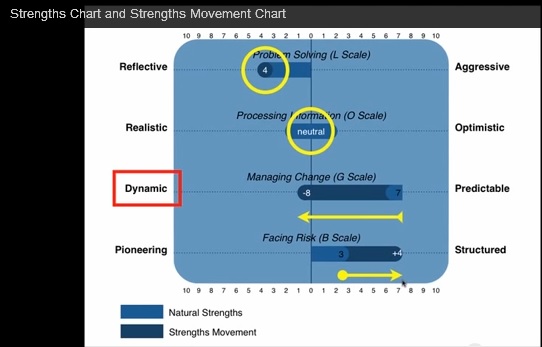 The Strengths Movement Chart shows each of the 4 predictable areas. Your natural strengths scores (medium blue) are overlayed with your adapted strengths scores, indicating strengths movement (dark blue).
The Strengths Movement Chart shows each of the 4 predictable areas. Your natural strengths scores (medium blue) are overlayed with your adapted strengths scores, indicating strengths movement (dark blue).
The chart indicates three kinds of adapted strengths scores.
- Neutral score: indicated by a circle on the overlay
- Positive score: indicated with a “+” on the scores overlay
- Negative score: indicated with a “-“ on the overlay
FAQ #2: Do the amounts of movements have significance?
The amount of movement in each of the four areas reveals how much you feel you need to adjust or compensate your natural strengths to match the requirements of your environment. Strengths movements over 5 points, whether positive or negative, indicate a significant need to adapt. Give these scores special attention.
FAQ #3: What creates a neutral score?
A neutral score, indicated by a circle on the overlay (see the top two scales in the image), shows that you are using your natural strengths in the most productive ways in your current environment.
FAQ #4: What creates movement in a positive direction?
Your adaptive strength in one or more of the four areas, when overlaid onto your natural strength in that area, may show a positive number (for example, “+4” on the lowest scale of the image). Positive movement shows you are using your strengths in that area – and your environment or people you work with may challenge you to use even more of it. The adaptations you make to use more of your strengths may take some energy, but not the significant amount required when you must use a strength that doesn’t come naturally to you. A positive score can be a positive stimulant, in that it allows you to develop your natural strengths.
FAQ #5: What creates movement in a negative direction?
Your adaptive strength in one or more of the four areas, when overlaid onto your natural strength in that area, may show a negative number (for example, “-8” in the image’s third scale from the top). When your adaptive strength score moves in the direction opposite to your natural strength score, you find you must use a strength that is not natural to you. Negative movement on a scale, particularly with a score of 5 or more or a score that crosses the energy line, indicates your environment requires you to use strengths that don’t come naturally to you. You may experience conflict in the environment or be asked to be something you are not. While challenges can helps you stretch and grow, you may also want to consider that the adaptation may be causing you excessive frustration or stress.
FAQ #6: What kinds of conflict lead to a significant number movement?
Number movement scores can indicate three types of conflict:
- Me-You conflict: an interpersonal conflict between you and another individual whose strengths differ from yours.
- Me-Job conflict: a vocational conflict. Here, your position requires strengths that are different from yours.
- Me-Me conflict: an internal struggle with yourself, found most often among those who have low self-esteem. No matter what strengths you have, a Me-Me conflict means you perceive your strengths are not good enough,
FAQ #7: How can I use this information?
As you study your Strengths Movement Chart, ask yourself these three questions:
- What kinds of movements do I find in the four predictable areas?
Study where scores show you have neutral movement, positive movement, or negative movement. Make special note of areas in which movement is 5 points or higher (regardless of whether it is positive or negative.) These scores indicate areas in which you are making considerable adaptations. - Where do I cross the line?
Note any areas in which your adapted strengths scores cross the energy line into the opposite strength. This shows areas in which you may expend considerable energy to adapt. Determine if your adaptation is Me-You, Me-Job, or Me-Me. - Should I take any action based on what I learned?
Study the information you have gathered to consider changes you may want to make to reduce stress, curb your frustration, and maximize your strengths. Share your conclusions with your spouse, a trusted friend, or a certified practitioner to make an action plan.
You can also learn more about using the Strengths Movement Chart in this short training video.
More FAQs: Frequently Asked Questions
FAQs: How to Customize Your Communication with People Who Have Other Strengths
FAQs: Report Consolidation Template – Your Profile on One Page
FAQs: Tight Patterns and Neutral Graphs
The Strengths Wheel is a powerful visual tool that plots natural strengths and adaptive strengths. It is included in each Leading From Your Strengths profile report.
Your scores are plotted on the wheel as a means for you to identify, at a quick glance, your natural strengths and adaptive strengths.
The wheel is especially useful for teams or groups of people. When you plot individual team members’ scores on the wheel, you get a picture of how the team works together as an organism. This allows you and your group to identify areas of collective strength, gaps in functionality, and how the team is moving their strengths collectively to meet the demands of their environment.
These are questions teams ask most often about The Strengths Wheel.
FAQ #1: What are the wheel’s four main quadrants?
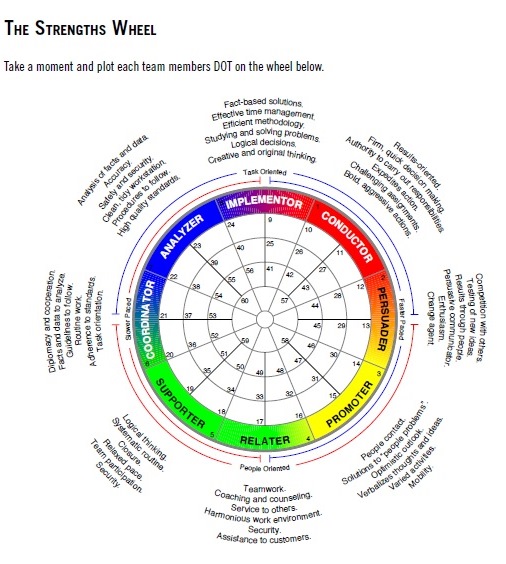 The wheel is divided horizontally and vertically.
The wheel is divided horizontally and vertically.
The horizontal division (North-South) reveals orientation. Those people plotting in the North (upper) half are task-oriented. Their strength lies in “getting the job done.” Those on the South (lower) half are people-oriented. They do their best work when they interface with people.
The wheel’s vertical division (West-East) reveals pace. Those individuals plotting on the left (West) side of the wheel operate best at a slower pace. Those plotting on the right (East) operate best at a faster pace.
This information is valuable as you plot your team. Does the environment encourage accomplishing tasks or emphasizing interaction with people? You may also discover if (as a whole) your team works methodically and deliberately (slower-paced) or at a quick, ever-changing environment (fast-paced.) Your team’s strengths wheel may reveal why certain people or portions of the team flourish or struggle to fit into the overall team environment.
FAQ #2: What are the dots and the stars on the wheel?
Your dot on the wheel indicates your natural style. Your star on the wheel indicates your adapted style. When your dot and star are positioned closely together on the wheel, you are likely operating in an environment that is a good fit for your strengths. If your dot and star are farther apart on the wheel, you may be operating in an environment that requires you to expend considerable extra energy to be effective.
By plotting your team’s dots and stars together on a chart you can discover your team’s group strengths – what the team does best. Areas with few dots indicate team gaps in strengths. You will also discover, by looking at the stars, how your team is having to adapt.
FAQ #3: What do each of the 8 terms on the outside of the wheel mean?
The wheel is divided like a pie into 8 wedges. Each wedge represents a group of strengths, identified on the outer ring of the wheel with a descriptor term: Conductor, Persuader, Promoter, Relater, Supporter, Coordinator, Analyzer, and Implementer. Note that all descriptors are strengths. None are better than another, but rather each is useful and needed.
FAQ #4: What do the numbers on the wheel mean?
The wheel has concentric rings. Together the 8 descriptor wedges and the concentric rings divide the wheel into 60 sections. Each section is labeled with a number
The results of your profile report produce numeric scores (#1-60). Each respondent is classified with two scores: one for natural strengths (the dot) and one for adapted strengths (the star), which are plotted on the wheel.
Note the different sections in which each person’s dots and stars are plotted: outer two rings, center two rings, or in the innermost circle.
- Outer two rings (#1-24): identifiers placed here reveal a person’s strengths are strong (even rigid) and consistent, likely in a variety of environments.
- Center two rings (#25-56): identifiers place here reveal a person’s strengths are more flexible, allowing him to adapt with more ease.
- Center ring (#57-#60): these identifiers reveal cross patterns in a person’s strengths, representing conflicts. This individual may experience struggle in using all of his strengths concurrently.
FAQ #5: How can we use this information?
As you and your team plot results on a master Strengths Wheel, ask these three questions:
- What are our team’s strengths? You may find that a large number of team members’ natural strengths are clustered in a certain area, such as a people-oriented half of the wheel. This information shows you a collective strength of the group and can reveal why your team accomplishes certain processes easily.
- What are our team’s gaps? The absence of certain natural strengths on the wheel can reveal why your team struggles in that area. For instance, most of your group members operate best in a slower-paced environment, then you may come to understand why the team does not operate efficiently at a deadline time.
- Should we take any action based on what we’ve learned? Perhaps you and your team may decide to fill gaps in your team with your next hire, seeking out an individual with a different strengths set to round out your team. Or you may note that your team members make significant adapted strengths adjustments, which causes them to use a lot of energy. You may be able to alter the environment or expectations to allow members to use their strengths the best.
More about The Strengths Wheel
The Strengths Wheel: Videos #1 and #2
More FAQs
FAQs: How to Customize Your Communication With People Who Have Other Strengths
FAQs: Report Consolidation Template – Your Profile on One Page
FAQs: Tight Patterns and Neutral Graphs
A. Assessments and companion products can be purchased in our online store, using a valid credit card (Visa, Master Card, Discover, or American Express). At the end of the checkout process, you will see your receipt displayed onscreen and receive a copy via email. Your credit card statement will display charges to Ministry Insights or Insights International. Q. How do I take an assessment?
A. If you have a passcode, please visit the assessment site at justrespond.com. If you purchased an assessment, also labeled “a usage,” via our store, log in to your account, then go to My Assignments > My Assessments. Q. Can I take the assessment if I am not at my own computer?
A. Yes, the Leading From Your Strengths® Assessment can be purchased and completed at any time, online. Your results will be delivered immediately to your inbox. Q. Can I purchase assessments as gifts for other people?
Yes. After you purchase your assessments, log in to your account, then go to Manage Users > Enroll Users to assign to a participant. Q. Are the profiles available in other languages in addition to English?
A. Currently, the Leading From Your Strengths Assessment is the only profile product fully translated into Spanish, meaning both the assessment and the profile results are available in Spanish. To choose this option, log onto the questionnaire website and select Spanish from the response language drop-down menu. Both your online questionnaire and profile results will be in Spanish; the purchasing agent for the profile will receive the profile results in English. If the purchasing agent is the respondent, he will receive two sets of results, one in English and one in Spanish.
The assessment can be completed in more than 30 languages by simply selecting a different language option at the questionnaire website. However, profile results are provided only in English (or Spanish). View the available languages at the questionnaire website by clicking on the drop-down menu in the upper right corner.
Q. How long does it take to complete an assessment and receive the profile report?A. Completing the assessment takes about eight to ten minutes. Once you finish, the profile report is immediately viewable as an Adobe Acrobat PDF and available for printing. A copy of the report is also emailed to you immediately. You will also find a PDF copy in your online account.
You can download Adobe Acrobat Reader software for free to view you’re your profile report PDF.
Q. What if I have problems receiving my profile report?A. Most delivery issues are caused by an undeliverable e-mail address. Reports will be returned to Ministry Insights if an email address is entered improperly. When you complete the assessment, you will have a chance to verify your personal and delivery information.
If you encounter issues receiving your report, please contact us through our Contact page. On the contact form, specify the type of profile you completed and approximately when you completed it. One of our representatives will get in touch with you and assist you as quickly as possible.
Q. Why do I occasionally see references to 4 letters (or animals) in the profiles?A. In the past, Ministry Insights tools equated each of the profiles’ four behavioral styles with a “word picture” of an animal, based on the original work of award-winning author and psychologist Dr. John Trent. Over time as respondents grew more sophisticated in using tools, they found the animal images to be distracting. Ministry Insights has gradually reduced references to the animal word pictures as a means of explaining the four quadrants of behavior. Q. How do I apply the profile report?
A. Reports help you understand your God-given strengths and provide an objective platform and practical statements to use for improving communication with others. Generally, the best method for applying the report is in sharing and discussing its content with others. To get the most out of your report, take advantage of our free downloads, books, articles, online leadership course, and online certification. Q. How can I know the profile and assessment are reliable?
A. The Leading From Your Strengths® process, assessment, and reports are based on a widely accepted behavioral language model and are well-respected as comprehensive, accurate, and user-friendly when compared with other behavioral profiles available. Ministry Insights profile perceived accuracy by users is 92.1%. Q. What if I disagree with my profile?
A. No assessment can ever take into account all of the complexities of a human or how they behave in all situations. As the psalmist wrote, “I am fearfully and wonderfully made” (Psalm 139:14). Nevertheless, the Ministry Insights profiles are generated based on responses to your assessment and reflect the unique behavioral style associated with those responses.
However, you may see a small percentage of feedback in your report that doesn’t apply specifically to you. We recommend that you explore these outliers fully by discussing them with someone close to you. After careful thought and discussion, if you still disagree with those statements, strike them from your report and focus on the statements that you agree with.
In rare instances, an individual who is experiencing high levels of stress may not be able to respond to the assessment with a high degree of clarity. If you feel this could be a contributing factor in the responses you provided, we recommend that you retake the profile at a later time when the stress in your life has subsided.
Q. How secure is my profile report?A. All profiles are completely confidential and are only delivered to the email address you provide and/or to the purchasing agent. Ministry Insights saves a copy of your report on a secure, dedicated server in case you misplace your report or need another copy delivered to your e-mail address. The Ministry Insights servers, websites, shopping cart, and online questionnaire processes are secured using the highest standards in Internet technology and computer security protocols. Q. How often should I take an assessement?
A. We recommend an assessment be retaken every 12-18 months or sooner if there is any significant change in your environment. Q. How do I reprint my profile?
A. Log in to your account and go to Completed Reports. There you will find PDF downloads you can click on and print. Q. Can I add a link to purchase the assessment on my website?
A. Yes – take these easy steps.
-
- On the Ministry Insights website, find the product you want to add to your site.
-
- Right click on its “Add To Cart” image.
-
- Click “Copy Link Location” or “Copy Shortcut,” copying the link to your clipboard.
-
- Insert the link into your site.
Understanding the Profile Report
Overview
Ministry Insights strengths-based profiles are objective, multi-page reports which accurately detail habitual patterns of behavior, thoughts, emotions, and communication. Every profile is unique – there are over 19,860 statically variances of the profile base on the user response.
Our report presents an objective analysis of predictable behavior while remaining personalized and encouraging. Most importantly, it provides sophisticated insights into the individual’s unique strengths. The profile does not measure cognitive reasoning, aptitude, motivations, or detrimental behaviors.
Profiles are compiled and presented instantaneously after the user completes a simple, 10-minute online assessment. Profile reports are delivered immediately via email.
How To Use Profiles
Users can begin to use the data as soon as they receive their profile report. Your customized report will provide practical steps to help you connect with others and communicate better.
How users choose to apply profile information is up to the individual, both in how to implement it and when to do so. We recommend you can take advantage of Ministry Insights’ additional support products to develop a more in-depth action plan to incorporate this new information into their daily life and relationships, both short- and long-term. Users can also work with a certified practitioner to understand the data at a deeper level and continue to implement it over time.
Profile Highlights
The profiles provide unbiased, tangible data to help individuals understand themselves better and build on their strengths.
- Strengths. Profiles help users recognize and understand their natural strengths and how they operate, addressing God-given abilities in solving problems, processing information, managing change, and facing risk.
- Adaptations. Profiles reveal how users make adaptations in order to be successful in their current environment. These adjustments can reveal where they expend excess energy and can be a key in helping establish an action plan to lead from strengths.
- Others’ strengths. Profiles help the user identify the strengths of those around him and understand ways to communicate effectively with them.
Recommended Assessents
My Account
My Assessments
Completed Assessments
Manage my Account
Login
Certified Resources
PDF Downloads
- Leading From Your Strengths Participants Workbook
- Certification Workbook
- Communication Handout
- Position Insights Process
- Descriptors
- Large Strengths Wheel with Descriptors
- Five Capitals Key Concepts Overview
- Built to Thrive Coaching Intensive Marketing Flyer
Exercises
- 3 x 5 card > https://www.
ministryinsights.com/3×5-card- game/ - Flip Chart > https://www.
ministryinsights.com/team- building-flip-chart-exercise- problem-solving/ - The Cup The Sleeve The Napkin – https://youtu.be/um1jHdO7DFs
- Remember When by Alan Jackson video – https://youtu.be/TOmZ66lIzJA
- All Team Building Exercises
FAQ
- Tight and Neutral Graph patterns > https://www.
ministryinsights.com/faqs- tight-patterns-and-neutral- graphs/ - Tight and Neutral Graph video > https://www.
ministryinsights.com/tight- patterns-neutral-graphs/ - How to Read Vertical to Horizontal Graph Visual – http://www.ministryinsights.
com/read-strengths-charts/ - Strengths Movement FAQs and Video – http://www.ministryinsights.
com/faqs-strengths-movement- chart/ - The Strengths Wheel FAQs and Video – http://www.ministryinsights.
com/faqs-strengths-wheel/ - Why Am I Not Placing on the Wheel – https://www.ministryinsights.com/placing-insights-wheel/
- FAQ – How to Customize Your Communication – http://www.ministryinsights.
com/faqs-customize- communication/ - FAQ – The Energy Line on the Strengths Charts – http://www.ministryinsights.
com/faqs-energy-line- strengths-charts/
Presentation Files
- Leading From Your Strengths
- Position Insights
- Five Capitals Concepts
Articles
- The Mystery of Differences
- The Law of Differences https://www.ministryinsights.
com/law-differences/ - Certification Law of Differences Death of Unity Tree https://www.
ministryinsights.com/lessons/ certification-the-law-of- differences/ - Team Building Exercise Law of Differences > https://www.
ministryinsights.com/lessons/ the-law-of-differences/ - Jewelers Goal> https://www.
ministryinsights.com/ devotional-set-gemstone/ - Pen and Hand >https://www.ministryinsights.
com/devotional-pen-hand- embracing-strengths/
Healthier relationships are possible.
Accomplish more. Become more. Do it together.


